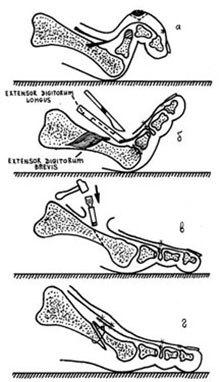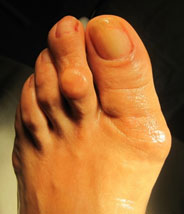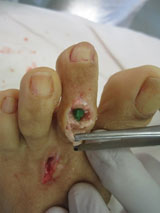Tests valid for 2 weeks:

- The foot – the second heart of the human body in Moscow
- The most important areas of the foot
- Thin base of the second toe
- What our fingers tell us
- 4 The little finger
- 5. fingers spread wide
- 6 The German foot
- 7. Clubfoot.
- types of feet
- 8. Crooked toe
- 9. the Egyptian foot
- 10. the Celtic foot
- We are on social media.
- The Roman foot - a measure of length
- The Celtic foot - a mix of cultures
- What complications can occur after toe shortening surgery?
- 'Bring youth back to your feet.'
- Frequently Asked Questions
- useful information
- Anesthesia in bunion surgery
- How to properly take a loaded foot x-ray
- How you can benefit from a personal consultation with me
- The variety of
- Types of arches.
- How the foot affects our body
- The glutes are weakened by:
- Foot and big toe – bunion
- Causes of long toes
- Surgery to shorten toe length
- diagnosis
- surgical treatment
- video overview
The foot – the second heart of the human body in Moscow
The foot is the second heart of the human body.He is responsible for the life of the entire body.
The foot is an important part of the human body. It is even referred to as the 'second heart of man'. This is because the arch of the foot contains the reflex points of many organs and there are many important channels. In total there are more than 60 active zones responsible for various organs and their proper functioning.
Thousands of years ago, people realized that those who walk a lot feel good, and longevity - these are mostly mobile people. Old doctors lifted seriously ill people to their feet very early on, so that they could recover more quickly and without complications.
Normal mechanical activity at the soles of the feet activates the whole body: as soon as a human stands up, the soles of the feet send activation signals to all corners of the body, but as soon as a human sits or lies down, these signals stop.
Doctors have now discovered that there are more than 70,000 nerve endings on the soles of our feet. These connect individual parts of the plantar surface to organs, body parts and even specific body systems.

The most important areas of the foot
Why cold and wet feet lead to cold or breathing problems
For this reason, wet feet are the most common cause of colds, which are accompanied by a runny nose and headache. The left paranasal sinuses are on the left fingertips and the right paranasal sinuses are on the right fingertips.
A little walking is enough to improve visual acuity and normalize intraocular pressure.
- At the front of the foot and at the side of the feet on the sole of the foot are the inner ear, pharynx, and bronchi.
- So when your feet get cold and wet, you can't avoid catching a cold with a cough, runny nose, and crackling ears.
- If you suffer frostbite. the top of the front arch of the foot at the base of the second and third toes, the sore throat can spread to the lungs.
For adults, whose immune systems are usually strong, frozen and wet feet don't always result in a cold. In children, on the other hand, there is a very close connection between feet and health.
Thin base of the second toe
This isn't just an artistic nature, it's a dramatic personality. Such people want to conquer the universe and the world with their actions and deeds. When they are in a good mood, everyone around them feels good. The slightest discouragement will cause the flowers in the room to wither, so it is better to leave them alone during this period. Over diply.com
I don't think the foot crease and the character crease really have definite similarities or mean the same thing
How nice to know once again that I am a leader! It really is. Useful article. Here's what every girl knows about her feet, thanks to the author!
New edition of the Hearth Network
Founder of Fashion Press LLC: 119435, Moscow, Bolshoi Savvinsky per. 12, bl. 6, floor 3, room II;
Address of the editorial office: 119435, Moscow, Bolshoi Savvinsky per. 12, bl. 6, floor 3, room II;
Editor-in-Chief: Rodikova Natalia Aleksandrovna
E-mail address of the editorial office: [email protected]
Editorial phone number: +7 (495) 252-09-99
Information Production Brand: 16+
The online edition is registered by the Federal Service for Supervision in the Field of Telecommunications, Information Technology and Mass Communications, registration number and date of the registration decision: Series EL No. FS 77 – 84131 of November 09, 2022.
© 2007 – 2023 Fashion Press Ltd.
By posting any material on the Site, you grant Fashion Press LLC the nonexclusive right to use, reproduce, distribute, create derivative works from, and display and make publicly available the material.
What our fingers tell us
4 The little finger

People who Having toes are in descending order (with a very small toe) They are quite outspoken, but there is one particular aspect to their personality - they are shy or a little secretive.
This restraint gives them a sense of security. These people can hardly be described as talkative. Given the choice, they prefer to keep their mouths shut about something intimate.
5. fingers spread wide

If there is a lot of space between the fingers or they are far apart, it is more likely that this configuration is an avid traveler.
People with this finger configuration have an innate thirst for adventure. They cannot stay in one place and are constantly looking for new and exciting experiences.
They only feel happy when they are on the move and cannot imagine life without a change of scenery.
6 The German foot

The owner of the so-called German foot The big toe is of pronounced size and the other four toes are almost the same length.
This type of person has the following characteristics . perseverance and hard work.. They are also easily inspired and passionate about a cause.
They easily clash with those who disagree with their views and argue until they win.
7. Clubfoot.

types of feet
8. Crooked toe

The thumb is tipped away from the other four toes, that are grouped together.
This finger configuration indicates someone who always likes to be the observer.
They have their own clear outlook on life and usually prefer to play devil's advocate in any situation, just for the sake of the argument.
9. the Egyptian foot

One One of the most common shapes of the feet. About 70 percent of people have this toe configuration.
The Egyptian or oblique foot is characterized by, among other things. a large protruding toe. The other four toes follow it in descending order, from largest to smallest.
As a rule, the owners of this foot are people who are soft and romantic. You are very emotional and trust people easily.
10. the Celtic foot

People with the Celtic foot type the second toe is pronounced, the third toe is slightly smaller, and the fourth and fifth toes are more or less the same size.
People with this toe configuration are more likely impulsive.
They are very difficult to convince when they have their own point of view, which they defend with great conviction. These people have tremendous willpower and are quite stubborn and religious.
We are on social media.





The Roman foot - a measure of length
The Romans left their mark all over Europe and North Africa at the time of their conquest. They invented the 'foot', a measure of length still used in Britain today.
The Roman foot has three toes of equal length, starting with the first. It is believed that this feature is characteristic of a quarter of the world's population. It is often found in Roman art, although the Greek foot is also found on many statues. The Romans often copied the work of Greek sculptors.
It is more difficult for people with this foot shape to find comfortable shoes. Shoes with narrow toes, stilettos and high heels are particularly problematic as they put pressure on the metatarsal bones.
The Celtic foot - a mix of cultures
The Celts are associated with Western Europe, particularly Britain, but their exact origins are uncertain. The shape of their feet and toes also indicates a mixture of different cultures.
The Celtic foot shape is a combination of Germanic and Greek toe shapes. In this type, the second toe is longer than the others, and the first and third toes are almost the same length. Genetic studies have elucidated the reasons for this combination.
The results show that regions of the UK where Celtic roots are prevalent, such as Cornwall, Scotland, Wales and Northern Ireland, are genetically very diverse. This means that there is no uniform Celtic genetic group.

genetics of origin. haplogroups
The Romans left their mark all over Europe and North Africa at the time of their conquest. They invented the 'foot', a measure of length still used in Britain today.
A study of DNA samples from more than 6,000 Europeans supports this theory. According to the results, European populations migrated to what is now Britain over the past 10,000 years.
The shape of the Celtic foot is possibly the result of the intermingling of several peoples.
What complications can occur after toe shortening surgery?
As with any medical procedure, side effects and complications can occur with toe shortening. The patient is always informed about this before the procedure. The main potential problems include:
The foot is made up of many small bones, joints and tendons. As a result, the smallest lesion in a toe often disrupts weight distribution. This can lead to bursitis, balance and coordination problems. Therefore, surgeons strongly advise people undergoing surgery for purely cosmetic reasons to carefully weigh the pros and cons. Still, it's better to wear closed-toe shoes and feel good than to sacrifice your health for nice sandals.
'Bring back the youth
Her feet.'
There are modern, safe and effective treatments available today to help you restore foot health. Some of these are completely free, others are very affordable. Unfortunately, many older people do not know this.
That's why I've created a new, unique campaign for the lovely older generation called 'Restore Youth to Your Feet'.
I invite you to my office for a FREE consultation where I will examine your feet.
I will also tell you what modern, safe and effective treatments are available for your situation and how you can get them for free or at the lowest cost. We will talk to you about all the options available and choose the one that suits you best.
1. Anyone over the age of 55 can participate.
2. You can apply with any foot and ankle problem.
3. The promotion runs from August 1st to September 30th, 2019.
4. You can come to a consultation in person in St. Petersburg at Jaroslawski-Allee 66, Building 1, or get advice online.
Call your mothers, grandmothers, relatives, friends - anyone who can benefit from my counseling. Tell as many people as possible, share on your social networks.
Old age is a wonderful time to enjoy life. So don't let pain and discomfort in your feet interfere with your quality of life. Let's get your feet back in shape together so walking can become your favorite pastime again.
If you would like to know more about the Make Your Feet Young Again campaign, write to WhatsApp +79219651182
or call us 8 (812) 336-60-22
Frequently Asked Questions
The surgery itself is no different. For all surgeries I perform I use the latest medical equipment, the best imported implants, high-quality consumables, the necessary medicines and I use regional anesthesia (a type of local anesthesia - two injections into the foot). There are only two differences in free surgery: 1. If you want to operate on both feet at the same time, you must perform the operation on two different days. The other foot can only be operated after 2 weeks. 2. When you have a quota, there is no aftercare. Follow-up care is always included in the price of the surgeries I pay for. This allows me to monitor how you are feeling, how your bones are healing and how your joint has regained mobility. In this way I can prevent possible postoperative complications. This always leads to excellent results and satisfied patients. Postoperative care can be purchased separately.
useful information
I'm talking about the treatment process. What to look out for.
How to get the best result.
How to make your feet healthy and beautiful again and maintain your quality of life for years to come.
Anesthesia in bunion surgery
I am often asked two questions: - What anesthesia is used for bunion removal - Can I choose general anesthesia to be unconscious during the operation.
In this video, I give in-depth answers to these two must-watch questions
How to properly take a loaded foot x-ray
In order to be able to correctly assess a forefoot deformity (hallux valgus), an X-ray recording is required under stress, ie the patient must be standing at the time of the recording.
We recommend the First Diagnostic Center at Calle Siqueirosa 10.
How you can benefit from a personal consultation with me
I am often asked why it is better to come for a consultation before the operation. Finally, you can send in your scans, chat on social media, and go straight to the operating table. I've been operating for 18 years and I've noticed a few things
The variety of
As with hands, feet come in a small range of shapes. Unlike the hands, their shape can also be influenced by non-genetic factors, e.g. B. by wearing shoes. Note that everyone's hands and feet are similar. If a man has big hands, he also has big feet; fat fingers exist on both hands and feet, etc.
Women's feet are not a smaller version of men's feet, they have a slightly different structure:
- The big toe is smaller (not as pronounced).
- The inner lines are slightly curved.
- The arches of the feet are higher.
- The foot itself is shorter due to the height.
- The length is shorter on the outside.

Types of arches.
These are particularly pronounced in the foot. With normal feet, the footprints show the inner and a little bit of the outer arch. With flat feet, these are not visible and the entire sole of the foot touches the ground. With a high arch (the opposite of flatfoot), only a narrow band connects the heel to the foot. Both foot shapes can cause muscle and back pain (although babies usually have flat feet, and arches don't develop until early childhood).

How the foot affects our body
A sedentary lifestyle negatively affects the entire back line. It starts in the feet and ends in the head. As the trunk stiffens, all of the tissue in the thorax crawls up and down the back. And it gets buttery smooth: the eyelids droop and you can no longer see the screen.
The gluteus extends, externally rotates, moves the trunk outward while the limbs remain still, and stabilizes in the frontal plane. We think that all the force of the gluteus maximus, as it contracts, moves the femur and creates movement in the hip joint. The reality is different when we look at the fascial tissue.

It turns out that only part of the fibers are connected to the bone. The larger part, on the other hand, is woven into the inextricably broad fascia. From the buttocks to the shin fascia, which runs down and over the knee joint. It attaches to the tibia. That means the buttocks are responsible for the knee and hip joints. And then the fabric goes down.
And where does the buttock end? Its connective tissue extends to the foot. It provides movement in the foot because it controls the movement of the shin and arch of the foot. The gluteus maximus is responsible for aligning the pelvic bones and aligning the pelvis with the foot.
I understand that this is all difficult to grasp the first time. But if you just touch your hips and try to move your feet, you will feel that the tissues under the skin are one. So it makes no sense to train the muscles in isolation.
The glutes are weakened by:
- a sedentary lifestyle (even if you exercise 3 times a week);
- chronic overstretching of the cruciate ligaments due to injury or trauma;
- diseases of the reproductive organs;
- S1 nerve root compression;
- Tension in the pelvic diaphragm and tailbone due to trauma or constant fear;
- Problems in the cervical spine.
Foot and big toe – bunion
The outflow of blood and lymph is disturbed when there is a disorder at one of the levels through which the blood flows: lower leg muscles, hamstrings, thigh muscles, small pelvis, abdominal organs, thoracolumbar diaphragm. A drainage disorder in these areas is manifested by swelling of the tissue surrounding the heel nerve. If the swelling persists for a long period of time, the thumb muscle becomes weak and a 'bone' forms.

Mechanical causes include arch prolapse and loss of thumb extension. The foot is forced to seek an area of support when the big toe is not functioning. Bone tissue begins to grow to provide stability to the stride.
Unfortunately, if you undergo surgery and don't change your lifestyle, the bone can start growing again. Remember that any surgery is an injury to the body, which it compensates by putting stress on other areas. This can lead to pain in the lower back or hip joints.
Causes of long toes
1) Genetics (heredity) is the most common cause.
2) A progressive valgus deformity of the big toe is usually manifested by a relative shortening of the first ray and a corresponding lengthening of the second ray of the foot. However, the absolute length of the bone does not change. The first metatarsal has only migrated to the side (primus virus). In this case, of course, the misalignment of the first metatarsal should be corrected, and then the relative length of the first toe (radius) will be correct.
3) Injuries to the heel and metatarsal bones can cause shortening of one of the rays.
Surgery to shorten toe length
There are several methods to shorten toe length. It is up to the doctor to decide which method to use, as the causes of excessive toe length, as mentioned earlier, can vary.
1) Metatarsal osteotomy - performed when the metatarsal bones are abnormally long.
2) Osteotomy of the phalanx only – performed when the phalanx itself is long.
3) Osteotomy of both phalanx and metatarsal bones – performed in case of hammer toe deformity and painful corns (metatarsalgia symptom with pronounced transverse flatfoot).
4) Proximal interphalangeal joint arthrodesis is performed for severe hammer toe deformity and stiffness. Also in patients who warn the doctor that they will only wear modeling shoes. Otherwise, hammer toe disease may recur.
Such operations are relatively fast. They last about half an hour. The operation can be performed on an inpatient or outpatient basis, depending on how the patient is doing. The patient can go home the same day.
New technologies enable minimally invasive foot operations. With hidden cuts and no external fixation with spokes. Recovery from these surgeries is much shorter and less painful.
There are practically no visible surgical scars. The recovery time is much shorter, so you'll soon be running in your favorite shoes again. In contrast, older, traditional surgical procedures used metal pins that protruded from the fingertip for four weeks. This not only made it difficult for the patient to comply with basic rules of hygiene (complete washing), but also significantly increased the risk of infection and the threat of migration of the metal structure from the presence of the spoke on the outside.
diagnosis
Clinical examination of the patient by the podiatrist, complaints, x-ray of the foot.
Used in the early stages of pathology, when the deformity is not yet fixed and soft. Orthoses, various orthopedic devices, ointments and tablets with NSAIDs, therapeutic exercises are used.
All these methods do not straighten the toe, but only stop the progression of the pathology.
When the deformity is rigid, conservative methods are ineffective and surgical treatment becomes necessary.
surgical treatment
Surgical treatment includes operations on soft tissue and bony structures.
If the deformity is passively corrected manually, a tenotomy or tendon lengthening may be sufficient to correct it. These can be combined with a relief of the capsule and the ligaments at the level of the metatarsophalangeal joint.
In the case of a rigid deformity, bone surgery is required:
- Resection of the phalangeal head and/or displacement of the long flexor tendon to the posterior surface.
- Resection of the proximal phalanx with transfer of the short flexor tendon to the plantar surface of the PFS.
- Arthrodesis of the proximal or distal interphalangeal joints of the finger.
- Metatarsal osteotomy.
- Arthroplasty of the proximal interphalangeal joint.
- A combination of different methods.



Don't waste your time and money! Don't risk your health!
At the first sign of symptoms, consult a qualified orthopedist. In our clinic we can help you quickly get rid of the disease.
video overview
Read more:- What types of doctors are there.
- structure of the toes.
- What types of foot.
- What types of doctors are there and what they do.
- structure of the toes.
- Short flexors of the toes.
- The child walks on its toes.
- Why are the big toes crooked?.
